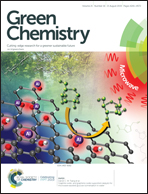Facile fabrication of a homogeneous cellulose/polylactic acid composite film with improved biocompatibility, biodegradability and mechanical properties†
Abstract
Fabricating a homogeneous cellulose/polylactic acid (C/PLA) composite material remains a challenge because hydrophilic cellulose (no melting point data available) and hydrophobic PLA are not mutually soluble at the molecular level, and they are also insoluble in the same solvent. Here, the fabrication of a homogeneous C/PLA composite film has been achieved for the first time by dissolving PLA in N,N-dimethylformamide (DMF), followed by the successive addition of cellulose and an ionic liquid 1-butyl-3-methylimidazolium acetate ([bmim]Ac). Interestingly, the C/PLA composite film fabricated from this procedure displays markedly improved biocompatibility, biodegradability, and tensile strength. The formation of the homogeneous C/PLA film mainly results from the mutual interference between cellulose and the PLA chains as well as the O–H⋯O![[double bond, length as m-dash]](https://www.rsc.org/images/entities/char_e001.gif) C hydrogen bond (HB) interactions during the coagulation of cellulose and PLA from the cellulose/PLA/DMF/[bmim]Ac solution. This study provides a new insight into the fabrication of homogeneous composite materials, which contain hydrophilic and hydrophobic compounds along with improved properties.
C hydrogen bond (HB) interactions during the coagulation of cellulose and PLA from the cellulose/PLA/DMF/[bmim]Ac solution. This study provides a new insight into the fabrication of homogeneous composite materials, which contain hydrophilic and hydrophobic compounds along with improved properties.



 Please wait while we load your content...
Please wait while we load your content...